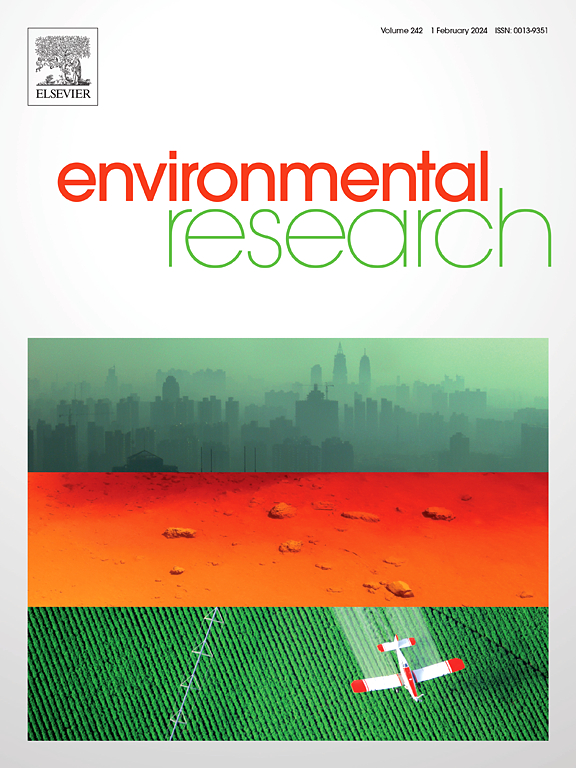Effects of web-based behavioral intervention on fine particulate matter, pulmonary function, and airway inflammation in children: The COCOA randomized controlled trial
IF 7.7
2区 环境科学与生态学
Q1 ENVIRONMENTAL SCIENCES
引用次数: 0
Abstract
Background
Although web-based intervention programs are effective in changing health behavior, evidence of their effectiveness in relation to air pollution and respiratory health in children is lacking. We assessed the effects of web-based behavioral intervention on exposure to fine particulate matter (PM ≤ 2.5 μm in diameter [PM2.5]), lung function, and airway inflammation in children.
Methods
We randomized 80 mother-child pairs into intervention or control groups (two arms, 1:1 allocation). Personal and indoor PM2.5 concentrations over a sampling period of 24 h up to four occasions during the study period were measured in participants' homes. We used linear mixed models to assess the intervention effects on PM2.5 concentration, lung function parameters including forced vital capacity (FVC), forced-expiratory volume in 1 s (FEV1), FEV1/FVC, and forced-expiratory flow at 25–75 % (FEF25 %–75 %), and the airway inflammation marker, fractional exhaled nitric oxide (FeNO), as well as the association of PM2.5 with lung function and airway inflammation. Quantile regression was also used to examine the effects of PM2.5 exposure at different quantiles of the outcome distribution.
Results
In comparison with the control group, the intervention group showed reduction in indoor and personal PM2.5 concentrations by 20.5 % (95 % confidence interval [CI]: −30.7, −8.9) and 12.9 % (95 % CI: −20.1, −5.1), respectively. Lung function parameters such as FVC, FEV1, and FEF25 %–75 % were higher in the intervention group, with greater benefits observed for children at the lower end of these parameters. Higher levels of outdoor and personal PM2.5 (≥90th percentile) were negatively associated with these lung function parameters at the lower quantiles, whereas the higher level of outdoor PM2.5 concentration was positively associated with FeNO at the lower quantile.
Conclusions
The behavioral intervention reduced PM2.5 concentration in the homes, which was linked to markers of lung function and airway inflammation in children, particularly at the lower quantiles.

基于网络的行为干预对儿童细颗粒物、肺功能和气道炎症的影响:COCOA随机对照试验
背景:尽管基于网络的干预方案在改变健康行为方面是有效的,但缺乏证据表明其在空气污染和儿童呼吸健康方面的有效性。我们评估了基于网络的行为干预对儿童暴露于细颗粒物(PM≤2.5μm直径[PM2.5])、肺功能和气道炎症的影响。方法:80对母子随机分为干预组和对照组(两组,1:1分配)。在研究期间,在参与者家中测量了24小时内多达四次的个人和室内PM2.5浓度。我们使用线性混合模型来评估干预对PM2.5浓度、肺功能参数(包括用力肺活量(FVC)、1秒用力呼气量(FEV1)、FEV1/FVC和用力呼气流量在25-75% (FEF25%-75%))、气道炎症标志物呼气一氧化氮分数(FeNO)以及PM2.5与肺功能和气道炎症的关系的影响。分位数回归还用于检验PM2.5暴露在结果分布的不同分位数上的影响。结果:与对照组相比,干预组室内和个人PM2.5浓度分别下降20.5%(95%可信区间[CI]: -30.7, -8.7)和12.9% (95% CI: -20.1, -5.1)。干预组肺功能参数如FVC、FEV1和FEF25%-75%较高,在这些参数的下端观察到更大的益处。较高水平的室外和个人PM2.5(≥90百分位数)与这些肺功能参数在较低分位数呈负相关,而较高水平的室外PM2.5浓度与较低分位数的FeNO呈正相关。结论:行为干预降低了家庭中的PM2.5浓度,这与儿童的肺功能和气道炎症标志物有关,特别是在较低的分位数中。
本文章由计算机程序翻译,如有差异,请以英文原文为准。
求助全文
约1分钟内获得全文
求助全文
来源期刊

Environmental Research
环境科学-公共卫生、环境卫生与职业卫生
CiteScore
12.60
自引率
8.40%
发文量
2480
审稿时长
4.7 months
期刊介绍:
The Environmental Research journal presents a broad range of interdisciplinary research, focused on addressing worldwide environmental concerns and featuring innovative findings. Our publication strives to explore relevant anthropogenic issues across various environmental sectors, showcasing practical applications in real-life settings.
 求助内容:
求助内容: 应助结果提醒方式:
应助结果提醒方式:


